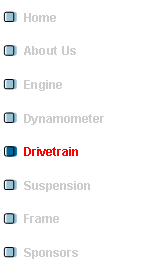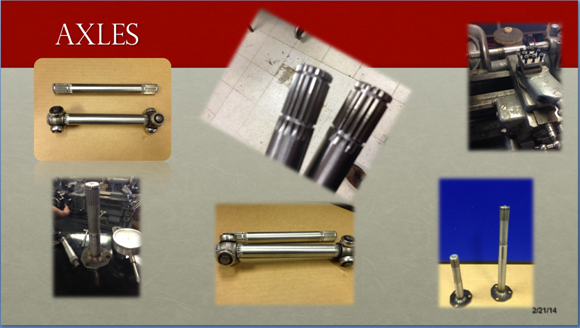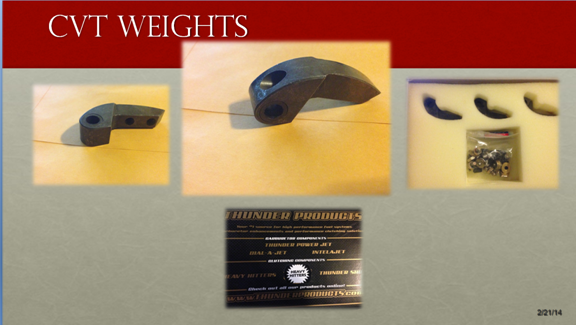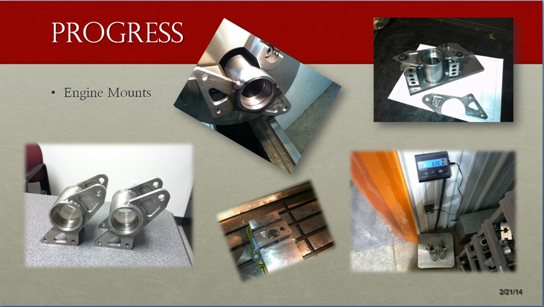
|
DRIVETRAIN TEAM |
|
††††††††††
.† Through the integration of the continuously variable transmission (CVT), the drive train will be tuned to extract the most power out of the motor under peak conditions.† One main design advantage of using the EFI controller and properly tuned CVT will allow for the motor to be held at maximum power allowing the maximum amount of power to be transferred through the secondary shaft and further to the chain driven sprocket.† The implementation of a 4:1 final drive ratio allows for the vehicle to hit its maximum speed as it crosses the 75m straightaway. Another key design includes the engine mounts; the initial design requirement allowed for the mounts to absorb a 4g force, also due to tighter packaging the mounts would support the motor at a 30 deg angle.† The final design allowes for the middle portion of the mount to be hollow, allowing the CVT secondary shaft to be supported by bearings in this location.
Our Progress
The drive train will be tested primarily on the chassis dynamometer. The tuning of the CVT is the primary objective of the drive train team, and the technical approach to tuning the CVT is to use a set of weights and springs that coordinate with one another to hold the engine at its peak power output. Using heavier weights or softer springs will cause the CVT to shift at a lower rpm. Accelerating the car quickly to top speed will allow for a faster time in the acceleration run. However, the tradeoff between too much acceleration and not enough top speed has to be decided through careful thought and testing. Testing of the previous year car will be done provide a baseline for the performance of the Phazer motor within a light weight formula car. The requirement is to have the car accelerate 75 m in less than 5 seconds. †††††††††† The drive train team has tested the previous yearís car for an acceleration run, however the run was unrestricted. This did not allow for the full effect of the operating conditions imposed by the real competition. Adding a restrictor into the engine makes the factory CVT tuning less adequate for the application, because the RPM and power output of the motor is being restricted, and the RPM of the output shaft is what drives the forces that allows the CVT to shift. The team will purchase spring and weight packages from Yamaha, after testing of the previous yearís car has been done while it is restricted, and correlations of what direction of springs and weights we should get are. †††††††††† The other main task that greatly determines the top speed and acceleration of the car is the gear ratio. The gear ratio will allow us to add or remove more torque to the rear wheels. Having a higher gear ratio will allow for the car to accelerate quicker, however if the car accelerates too quickly and does not have enough top speed then the quick acceleration becomes useless. Designing a set of sprockets to fit the carís 75 m acceleration run correctly is the major task. In order to test this, the dynamometer as well as acceleration runs on the car can be tested. The other main objective in the gearing is the differential. In order to accelerate through corners faster one wheel must be spinning faster than the other in tight corners. This is where the team has decided to use a cam and pawl limited slip differential. This limited slip differential allows for the wheels to be spinning at different speeds, so that corners are not an issue. †††††††††† Axle design is crucial to the car as well. The power being transmitted to the rear gears is useless if the power cannot be transmitted through the wheels. The axles must be designed so that they align and match up with the suspension teams wheel assemblies that they design. The axles must also be able to withstand loads that are applied to them, and testing for fatigue and developing a factor of safety must be done, so that failure does not occur. |


